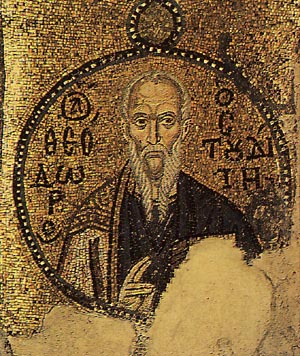Studion Monastery

Studion Monastery, also Hagios Ioannes Prodromos en tois Stoudiou (Saint John the Forerunner at Stoudios) was one of the most important monasteries at Constantinople until the fall of Constantinople to the Ottoman Turks. The rules and customs of the monastery became the model for monks at Mount Athos and other monasteries of the Orthodox east. The monks, referred to as Studites were in the forefront of many disputes in Constantinople, particular the extended iconoclastic battles of the eight and ninth centuries.
History
The monastery was founded in 462 or 463 with monks from the monastery of Acoemetae by the consul Studios, a Roman, in the section of Constantinople called Psamathia. The monastery was dedicated to St. John the Forerunner. During the disputes of the late fifth century, the monks of the Studion, and with Daniel the Stylite, remained steadfast for Orthodoxy relative to the issues of the Eutychian debates and monophysitism in disputes among Patriarch Acacius of Constantinople, the Roman emperors Zeno I and Basiliscus, the patriarchs of Alexandria, and the bishops of Rome.
During the eighth and nine centuries the monastery, led by a series of zealous abbots, maintained strong Orthodox positions during the iconoclastic period. Hegumen Sabbas zealously defended the Orthodox doctrines against the iconoclasts during the Seventh Ecumenical Council in 787. About 798, Theodore of the Sukkudion monastery was asked by the Empress Irene to lead the Studion monastery. Under the leadership of Theodore the Studite, as he became known, the monastery reached its peak in fame as it fostered academic and spiritual study. The defense of Orthodox belief, however, was not without its dangers. Theodore and the monks were often harassed, even driven from the monastery during Theodore’s tenure as abbot.
The monastery was led by a succession of able abbots after St Theodore. These abbots included Naucratius, Theodore’s disciple, who re-established discipline after the chaotic iconoclastic period closed. The monastery maintained its position of importance from abbot Nicholas in mid ninth century through abbot Simeon in the eleventh century after which Studion’s brilliance began to fade. The monastery was noted at its height for its intellectual life, its school of calligraphy that was established by Theodore, as a center of religious poetry, and for its assemblage of theological writers.
The monastery was seriously damaged during the Crusader conquest of Constantinople in 1204 and did not recover physically until 1290. By this time the stature of the Studion monastery had decayed further. With the capture of Constantinople by the Ottoman Turks in 1453, the monastery was largely destroyed. The only part of the monastery to survive to modern times is the Cathedral of St. John the Forerunner, which is probably the oldest church in modern day Istanbul. The fifth century basilica had been converted into a mosque. The ruins of the monastery complex now lay abandoned and subject to looting by the local people looking for material to repair their residences.
